The History Behind The Creation Of The Statue Of Liberty
The Statue of Liberty in New York City stands atop a 19th-century poem by Emma Lazarus. It reads, “Give me your tired, your poor, your huddled masses yearning to breathe free.”
Most people know the appearance of Lady Liberty, but few are aware of her secrets. Let’s take a closer look at this incredible statue!
Lady Liberty And Her Symbolic Stance
On Liberty Island in New York Bay, the 151-foot-tall Statue of Liberty stands proud and firm. With her right hand, she holds up, high above her crown, a symbolic flame.
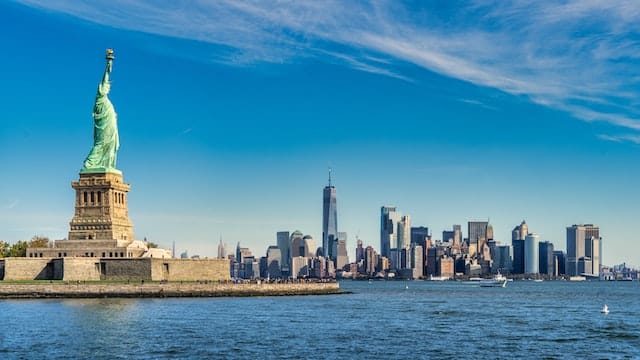
Source: Unsplash
The flame symbolizes a light at the end of a long tunnel filled with hardship and pain. A patriotic message, it inspires the nearly four million citizens and non-citizens of the United States of America who visit Lady Liberty each year. But most visitors are unaware of the significance found in other details on Lady Liberty.
Take A Good Look
Visitors have the pleasure of viewing the enormous 305 feet tall statue from the symbolic torch at the top to the feet at the ground level. It is a sight to behold.
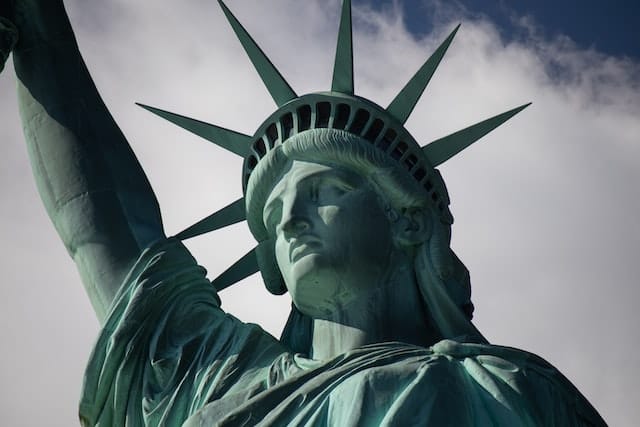
Source: Unsplash
Although the statue has become a symbol of American identity and pride, it was not designed by an American. Interestingly, a Frenchman first thought up Lady Liberty and eventually revealed her to the world.
France And The Original Liberty
1865 marked 100 years since the United States won its independence from Britain. The French scholar and poet Édouard de Laboulaye thought of different ways to celebrate this independence.
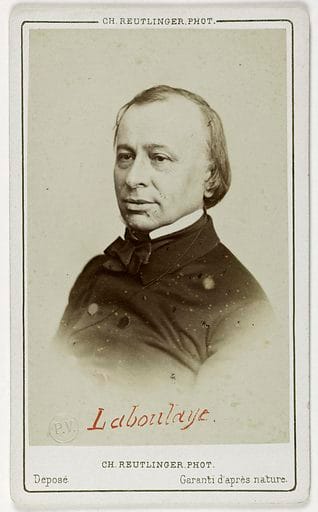
Source: Wikimedia Commons
He wanted to capture the spirit of liberty. Since he was not a designer but rather a scholar, he wrote down his ideas as best he could. With tremendous luck and fate, his ideas were brought to the attention of a famous sculptor—finally, someone who could make his ideas come to life.
Bringing It All To Life
Édouard de Laboulaye’s unique ideas caught the attention of French artist Frédéric-Auguste Bartholdi. Right away, he was inspired to work on it and bring it all to life. So he began his process by sketching and then, eventually, sculpting.

Source: Wikimedia Commons
However, he realized that the project would soon be a massive one. If it were ever to become a reality, he would need to work with a team. Figuring out how to make such a giant copper statue stable enough was the main problem, so he sought assistance from others.
Calling In The Big Guns
What kind of assistance did he get? Not simply a local artisan who was looking to kickstart his career. No, he found Alexandre Gustave Eiffel. Perhaps the most prominent engineer of the time.
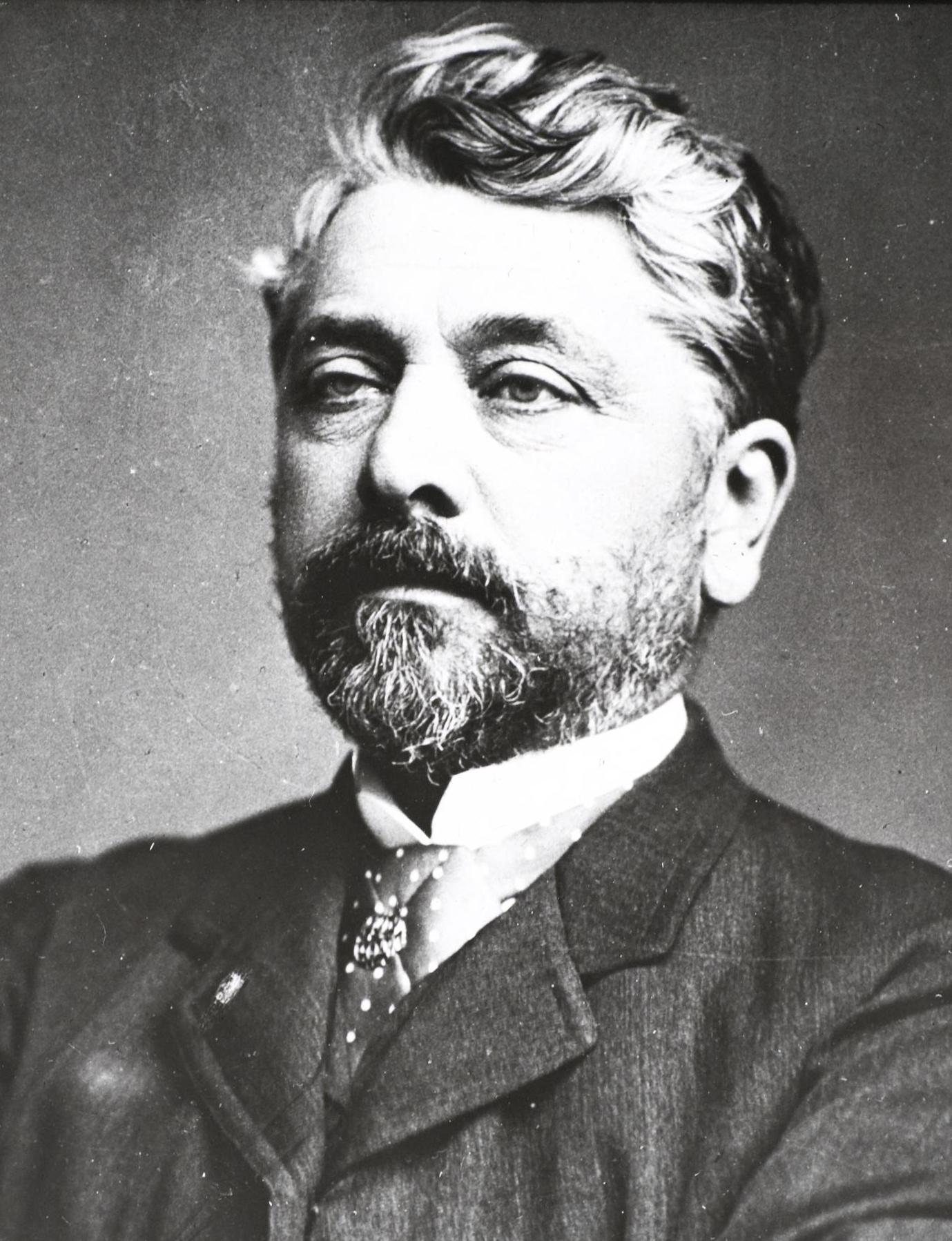
Source: Wikimedia Commons
If the name doesn’t ring a bell, here’s a refresher: he’s the civil engineer behind the world-renowned Eiffel Tower in Paris, France. He also built bridges for French railways, including the superb Garabit viaduct. Together, Eiffel and Bartholdi worked on the symbolism that would eventually become Lady Liberty.
The Importance of Symbolism
Both Bartholdi Eiffel took an interest in how symbols positively affected people’s minds. So they used their knowledge and experience to create the Statue of Liberty (aka Liberty Enlightening the World).
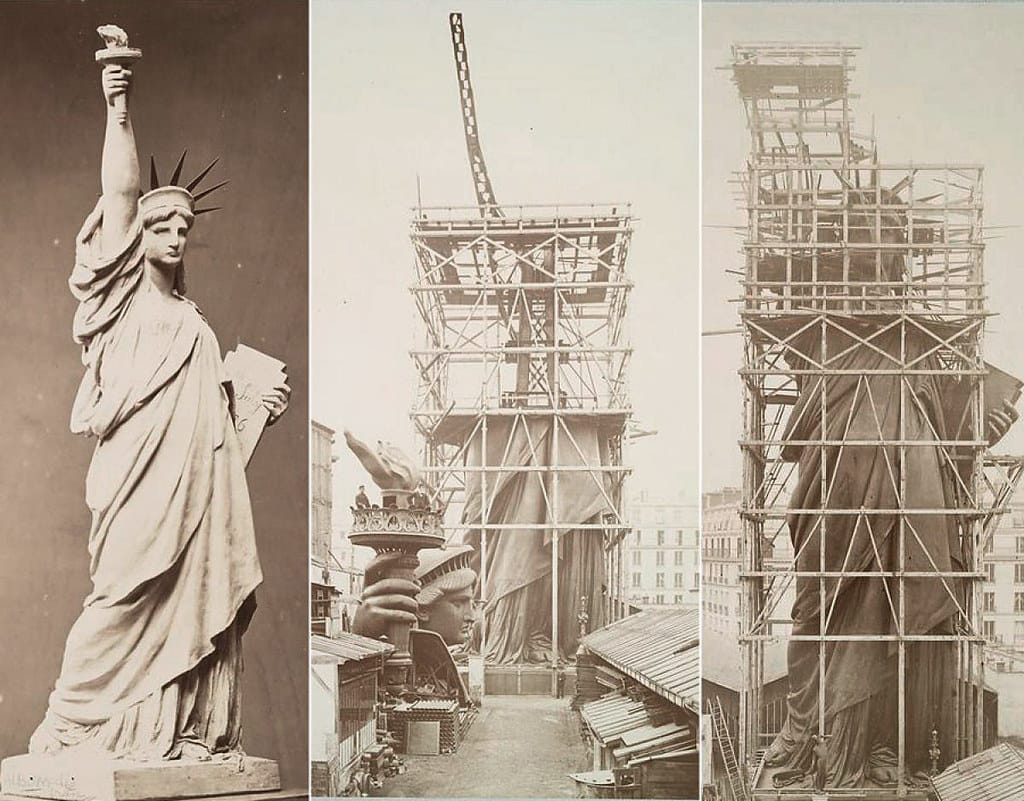
Source: Flickr
One important example of symbolism is the statue’s famous spiked crown that rests atop her head. With seven spikes, these represent the world’s seven oceans and continents. However, in her left hand is something much closer to Americans.
A Magnificent Declaration Of Independence
Anyone looking at Lady Liberty can see the torch she holds proudly in her right hand. However, what is she holding in her left hand? It’s difficult to see from the ground, but it turns out that she is carrying a tablet.
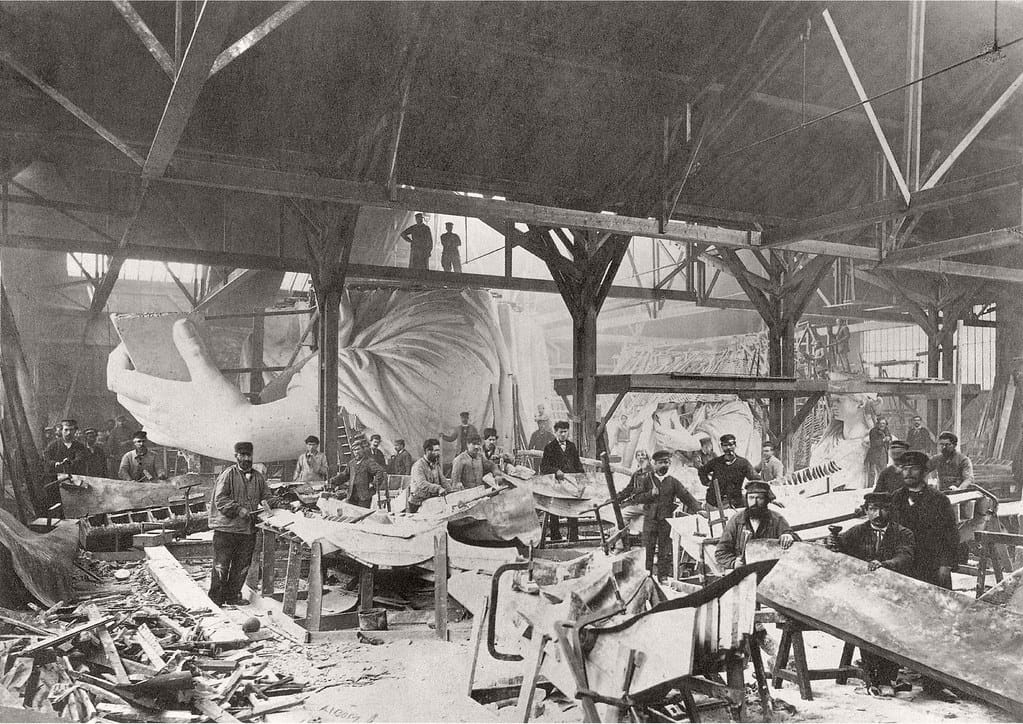
Source: Flickr
Roman Numerals – JULY IV MDCCLXXVI – are inscribed onto the tablet. When translated into English, it reads “July 4, 1776”. The famous date of the ratification of the Declaration of Independence. This particular piece of symbolism was added late but is meaningful nonetheless.
Sculpting Is Extended
Bartholdi was a very ambitious man that was full of hope. He started work on the Statue of Liberty in 1875, intending to unveil it by July 1876—the 100th anniversary of the Declaration of Independence.
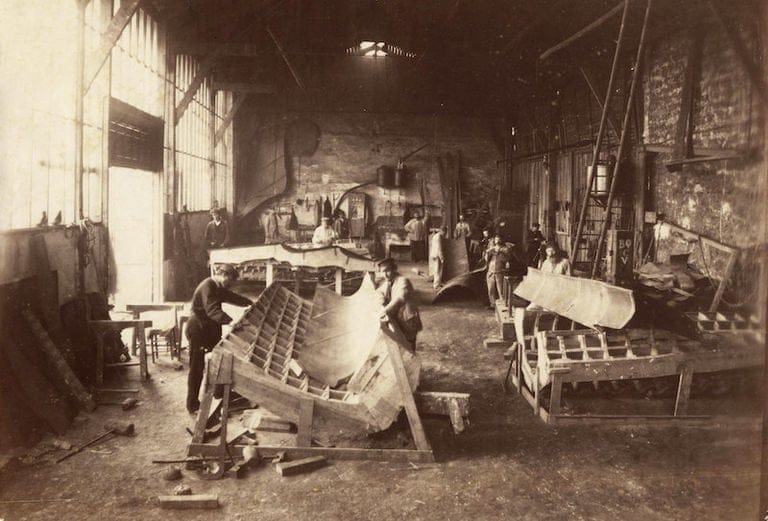
Wikimedia Commons
Well, that didn’t happen. Instead, all the work involved became far greater than Bartholdi had ever imagined. With everything that needed to be accomplished, it wouldn’t be until 1884—nearly eight years after the original expected completion date.
Site Of Controversies
Many Americans were aware of the sculpture as it was being built. Although it was a massive gift from the French to the United States, many Americans were skeptical about its message and symbolism.
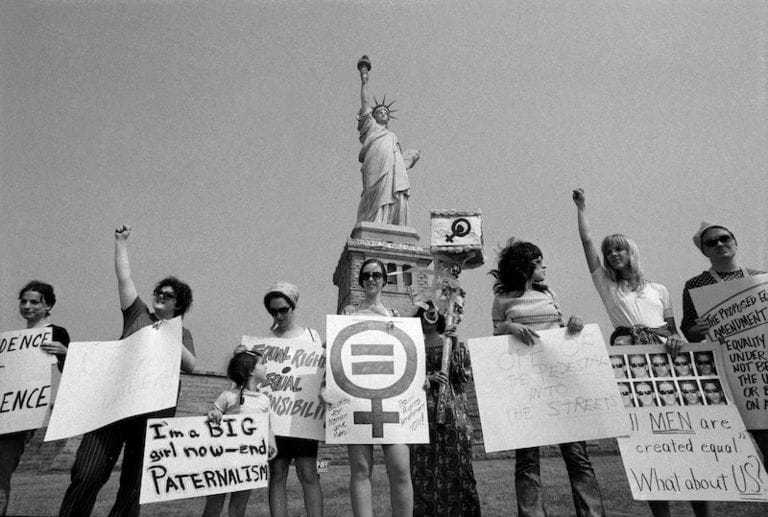
Biji
Activists and suffragettes working toward getting women the right to vote were understandably annoyed by the statue. It showed a female figure of liberty being placed on a land that didn’t allow women to vote. The symbolic torch was meant to acknowledge and counteract the skepticism that many felt.
An Enlightened Light For Everyone
The torch is vital to the entire monument because it’s one of its most recognizable features. That wasn’t by chance, it was by choice. Eiffel, Bartholdi, and Laboulaye were keenly aware of giving symbolic power to this statue.

PAUL DEMARIA/AFP/Getty Images
The torch is meant to represent enlightenment, a light that guides people toward freedom and liberty. True as that may be, it was also a pain to move. The problem of how to get it across the Atlantic Ocean was a big one.
Shipping Lady Liberty Across The Atlantic
Although the logistics were difficult, that didn’t stop Eiffel and his team from trying their best to solve it. They landed on a three-part solution: complete the assembly in Paris, disassemble it into parts that can be shipped across the Atlantic, and reassemble it in New York City.

Library of Congress / Wikimedia Commons
Their bold plan worked. The disassembled bits of Lady Liberty were shipped across the ocean and arrived in New York City on June 17, 1885. Soon after, the re-assembly process began in earnest.
Immigrants Come To The US
Although you might think the reassembly of the Statue of Liberty would only take a few days, that would be wrong – it ended up taking over a year! Once it was all rebuilt, the statue was set up to greet a large influx of immigrants coming off boats from the Old World.

National Park Service
Many left Europe and other places to create the kind of life that the Statue of Liberty promised – one of freedom and liberty. The early immigrants even got an experience with Lady Liberty that few have had since.
The Torch Explodes
The early visitors to the Statue of Liberty were often immigrants who left their home countries to try and create something new in the United States. When they visited the statue, they were able to walk all the way up to the torch itself.
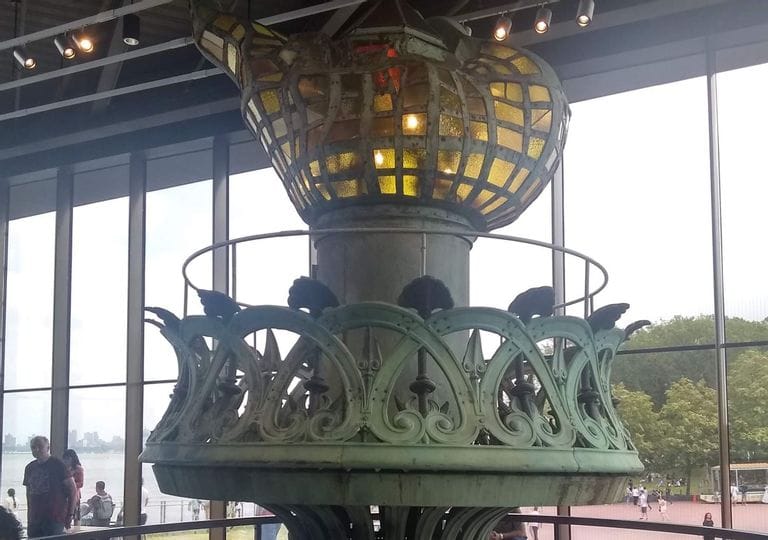
Epicgenius / Wikimedia Commons | CC BY-SA 4.0
However, this all changed in 1916. During World War I, German spies damaged Lady Liberty by causing a huge explosion that permanently closed the torch area. The statue would play a role in future wars as well.
Protests At Lady Liberty
Liberty Island was the site of multiple protests during the 1970s. The first came in 1970 when women’s rights activists protested the unequal laws that held them back. Shortly thereafter, another protest took place – this time against the Vietnam War.
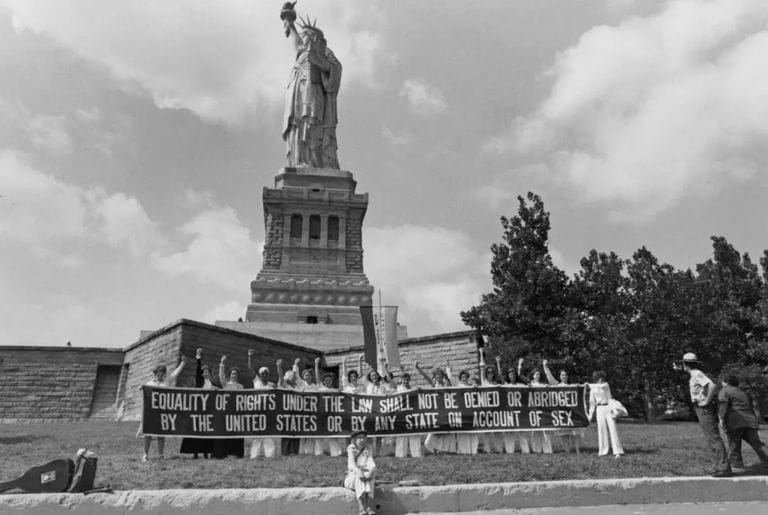
National Park Service
The Liberty Island location was chosen because of its symbolic value. Lady Liberty held the torch of enlightenment in one hand and the Declaration of Independence in the other – yet these protesters felt that the government wasn’t living up to the ideal.
The Foot Is Raised
The spiked crown, torch, and tablet are clearly the most visible and symbolically powerful design features of the Statue of Liberty. Most people know and recognize them. However, they aren’t the only meaningful aspects.
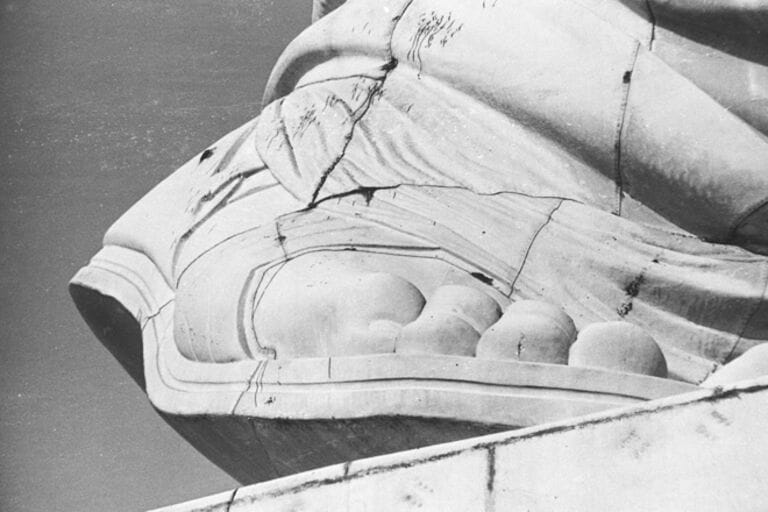
Three Lions/Getty Images
The statue’s right foot is very symbolic as well. Rather than go for an easy flat foot stance, the designers (Eiffel, Bartholdi, and Laboulaye) chose to have her foot slightly raised off the ground. We know they were obsessed with symbolism, so why did they design the foot this way?
Breaking The Shackles
The mystery gets solved by taking a look at the other foot, the left foot. As you can see clearly from below, there is a chain attached to it. Or, rather, there was a chain attached to it – before it was broken.
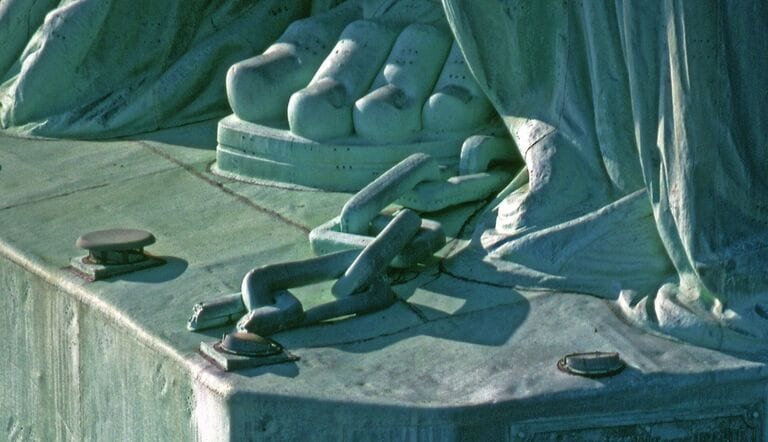
statueellisnps / YouTube
That broken chain was a powerful source of meaning for the French scholar Laboulaye who initially thought up the idea. It represented the Statue of Liberty boldly freeing herself from the shackles of tyranny that sought to keep her down.
A Message Of Hope
The French scholar Laboulaye had a variety of motivations behind his desire to design and gift a Statue of Liberty to the United States. One motivation was, undoubtedly, his huge admiration for the US. Another was his ardent belief in ending slavery.
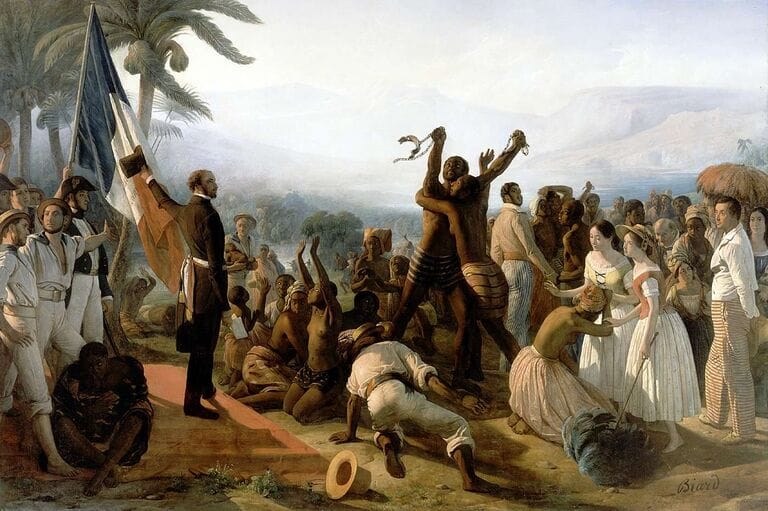
François-Auguste Biard / Wikimedia Commons
Laboulaye was an ardent abolitionist who was co-founder and president of France’s Anti-Slavery Society. Although at the time, slavery was abolished in France and the US, the society believed it should be banished from every country on Earth.
An Enduring Monument
As we have seen from above, the Statue of Liberty is a monument filled with symbolism. Alongside the torch of enlightenment lighting the path to freedom and liberty, we have the strong anti-slavery message that Laboulaye fit into its design.
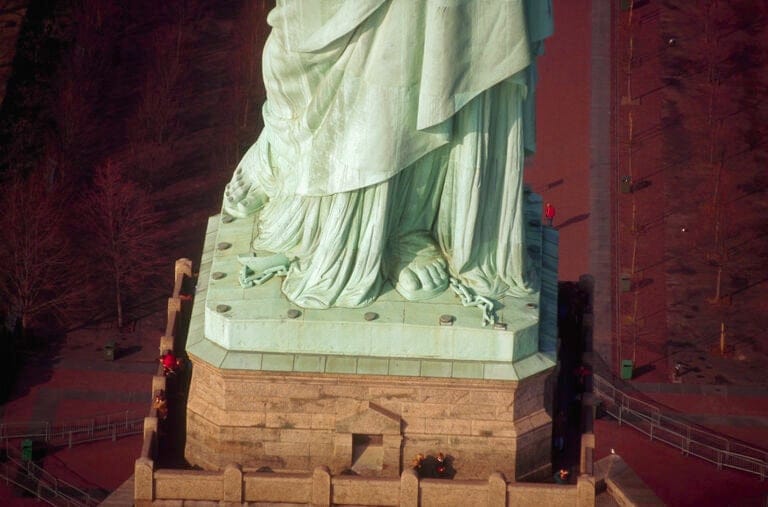
Richard Hamilton Smith / Getty Images
In many ways, they go hand-in-hand. How can you have freedom and liberty while, at the same time, having slavery? It just doesn’t make sense. Alongside those pieces of meaning, there is also one more vital part to the statue.
The Poem At The Base
In 1883, money was needed to help finish the massive Statue of Liberty undertaking. Part of that fundraising was inspired by a poem written by Emma Lazarus. Titled “The New Colossus,” it speaks of America as a sort of promised land, a sanctuary where those who are down on their luck can build themselves back up again.
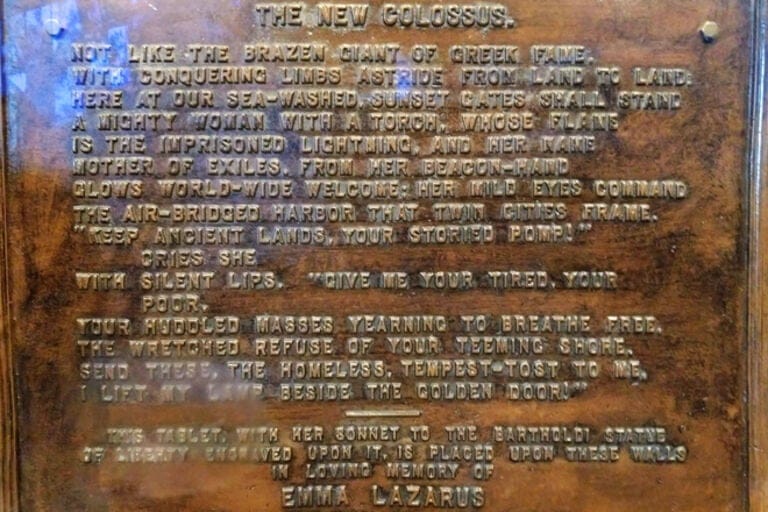
Library of Congress Public Domain
It was (and is) a powerful poem that was engraved on a plaque beneath Lady Liberty’s feet. It stayed there for nearly 116 years before it caused some controversy.
An Attempt To Modify The Poem
In 2019, a top immigration official said in an interview that he wanted to rewrite some of Emma Lazarus’s famous poem. For example, he would do away with Lazarus’s line, “Give me your tired, your poor, your huddled masses yearning to breathe free.”

Library of Congress Public Domain
Instead, he suggested replacing it with, “Give me your tired, your poor, who can stand on two feet and won’t become a public charge.” Although it caused controversy in the news, the poem ultimately wasn’t rewritten.
Continued Source Of Inspiration
Emma Lazarus’s 1883 poem, “The New Colossus” has a certain timeless quality about it that inspired millions of people when they first set foot on American shores. When it was cast in bronze in 1903, the poem and Lady Liberty were forever linked in their campaign to welcome those who want to escape persecution.

Pixy.org
Over the 118 years or so since that poem and statue have been together, millions more continue to be inspired and emboldened by the power of symbolism of the two.
Statue Of Liberty’s Legacy
The story of the Statue of Liberty’s creation is nearly as impressive as the statue itself. From the mind of scholar Laboulaye, it moved to the designs of Bartholdi and the engineering feats of Eiffel. It was created in Paris, sailed across the ocean, and rebuilt in New York.
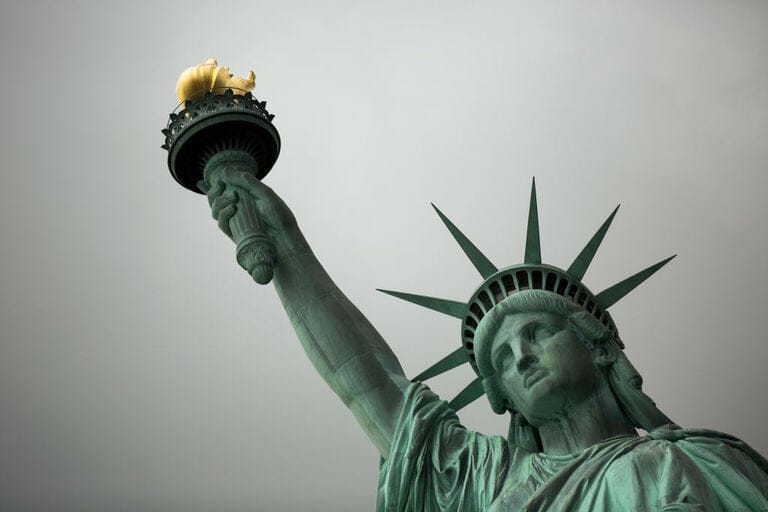
Drew Angerer/Getty Images
It connected the “old world” to the new and inspired millions of immigrants who left that old world lifestyle for a new beginning. The statue is filled with secrets – some we have seen above, others we will find out below.
Lighthouse Liberty
After the Statue of Liberty was finally rebuilt and installed on Liberty Island in 1886, the bright torch was working double duty. It was so bright that it was used by captains at sea as a lighthouse – for nearly 20 years!

John Becker
Sailors in the Atlantic Ocean who were up to 24 miles away from the island could see the powerful light emanating from the Statue of Liberty. To generate that power, a power plant was constructed on Liberty Island to serve the iconic torch.
The Statue’s Many Names
Being such an iconic image of the United States of America and its cultural values of freedom and liberty, the Statue of Liberty has taken on quite a few names over the years. The full formal title is not the Statue of Liberty – it’s the Statue of Liberty Enlightening the World.

oversnap / Getty Images
Since that’s too long a name for most folks, people have shortened it to Statue of Liberty. Other informal nicknames include Mother of Freedom, Green Goddess, Lady Liberty, and Lady of the Harbor.
A Gift To Paris
When Eiffel, Bartholdi, and their team finished assembling the full Statue of Liberty in Paris during the 1880s, they were so taken by the significance of the sculpture that they kept behind a (much smaller) nine-foot version of Lady Liberty.
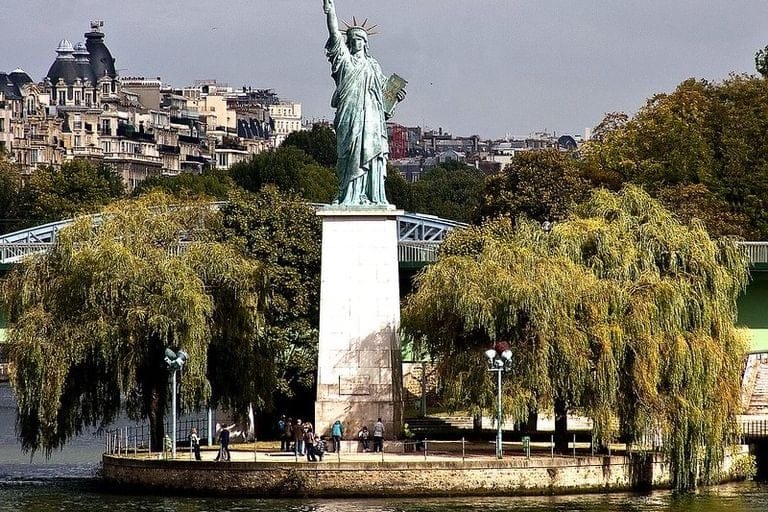
Jean-François Gornet / Flickr
Although compared to the 151-foot statue sent to the US, it wasn’t much, it still captivated the imagination of Americans living abroad in Paris. In 1889, they banded together to create a quarter-size replica and gave it to the city of Paris.
Taller Back In The Day
To better appreciate the size of the Statue of Liberty, it’s best to imagine what New York City was like back in the 1880s. This was a few decades before skyscrapers began dotting the skyline. Back then, the 151-foot Statue of Liberty stood out from its surroundings.
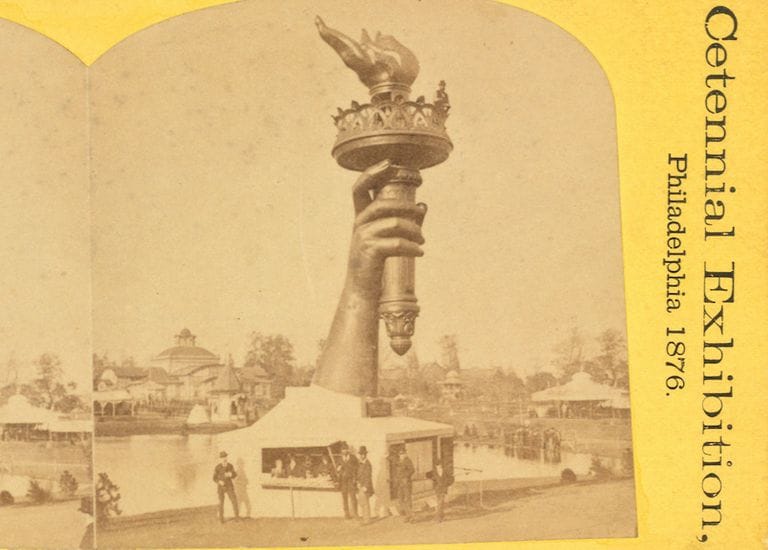
Wikimedia Commons | PD
Partly because that 151-foot statue stood on top of a pedestal that measured around 154 feet tall. So, in total, from ground to torch, the Statue of Liberty stood 305 feet tall – the size of a 21-story building!
Comparing A Human And The Statue
On top of her impressive height, the Statue of Liberty – or, if you want to be formal, the Statue of Liberty Enlightening the World – has other impressive features. Any size human standing next to the statue would soon feel themselves to be incredibly small.

Today Show
For example, the statue’s index fingers stretch out to eight feet in length. If you put your feet next to hers, her feet would dwarf yours – the sandals are nearly 25 feet long! In human shoe sizes, she officially wears size 879.
A Panoramic View
If you are a visitor to the Statue of Liberty nowadays, you’ll find that you don’t have to stay outside to admire the exterior – you can also explore the interior of the statue! In fact, visitors can follow a special spiral staircase that leads all the way to Lady Liberty’s crown.
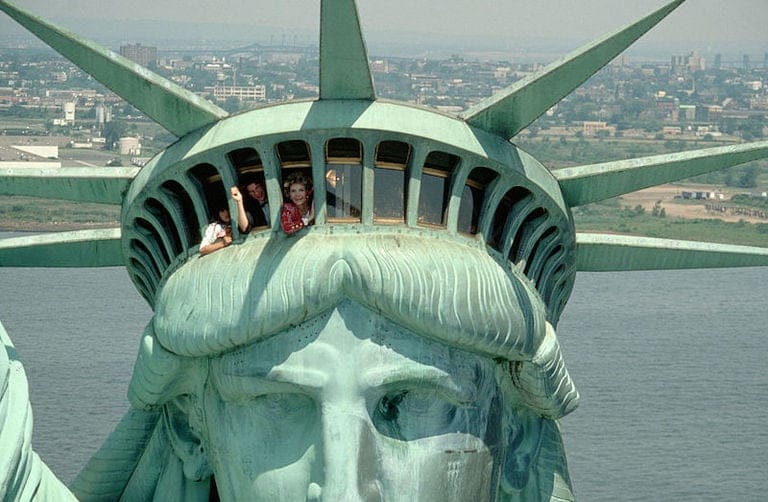
Wally McNamee/CORBIS/Corbis/Getty Images
Once there, you’ll have quite the view. As you can see from the picture above, there are plenty of windows – 25 in total – that allow a panoramic view of New York Harbor.
Virtual Views
During the early days of Lady Liberty’s life, brave visitors could climb all the way up to the actual torch. At 305 feet high, it wasn’t for the faint of heart.
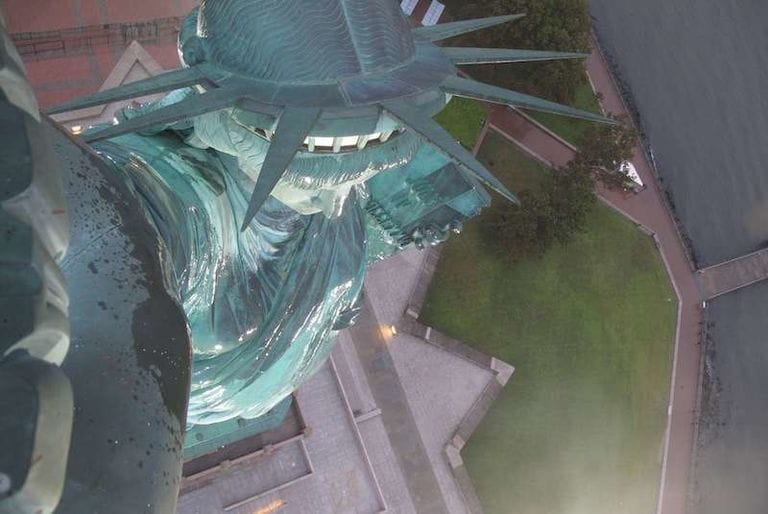
Earthcam.net
That was ended, however, due to a bombing in 1916. German spies blew up a munitions factory nearby and the shrapnel damaged the statue. The stairs to the torch were deemed unsafe for the public, so it was closed. Nowadays, there is now a virtual TorchCam that gives you views from the safety of your home.
Filled With Meaningful Symbols
As we’ve seen from above, the design for The Statue of Liberty was meticulously plotted out – which is partly why it took so long to build. On top of all the engineering challenges, there was the conceptual challenge of deciding on the right symbolism.

Dustin Tyler Joyce/Flickr
Eventually, it was solved and the result is what visitors see today. Lady Liberty’s spiked crown uses seven points to represent the seven seas and seven continents. Also, she looks out to the southeast where most arriving ships come from. She truly is a guiding structure.
Changing Color
Although for most of us, the color green and the Statue of Liberty go hand in hand, that wasn’t always the case. In fact, when she was first installed in the late 19th century, she was the color of a new penny.
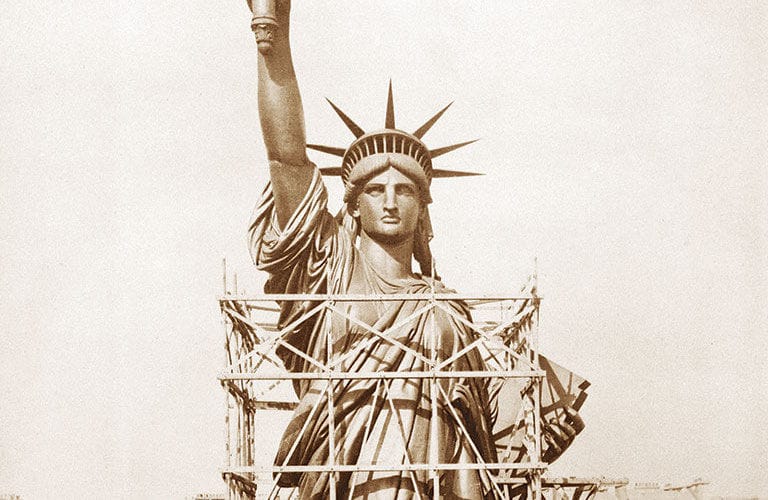
That’s because the statue is mostly made up of copper. However, after only 20 years of copper brown life, the natural elements in New York Harbor oxidized the copper and changed it into the green we see now.
Lightning Strikes
As we all know from high school science class, lightning tends to strike tall things. Unfortunately for the Statue of Liberty, she’s the tallest point in New York Harbor – so she gets struck. A lot.
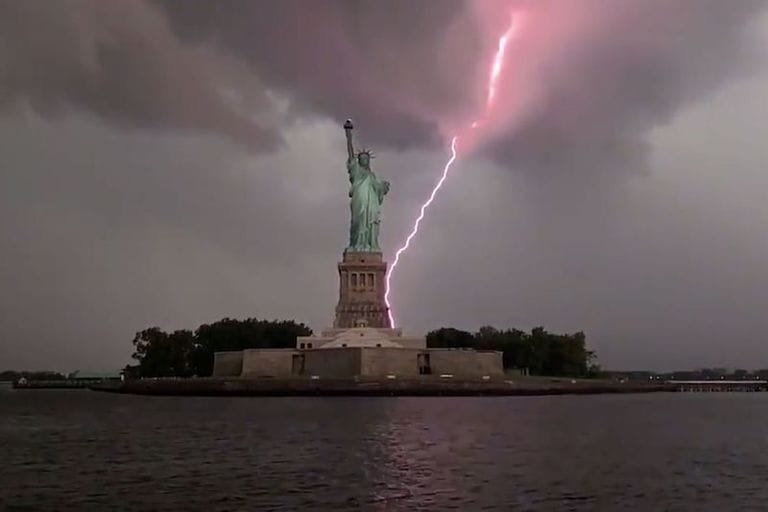
Statue of Liberty NM / Twitter
Lady Liberty experiences lightning strikes so often that the National Park Service, who manages the statue, often loses count. However, estimates tend to hover around 600 times per year. Ouch! Luckily for the statue, the concrete and granite material ends up grounding the electricity without causing much damage.
Happy Birthday Renovations
The Statue of Liberty was initially meant to celebrate the 100th anniversary of the signing of the Declaration of Independence. Although their timing was off, the sentiment stuck. So when it came time to celebrate the 100th anniversary of Lady Liberty, preparations were made well in advance.

NPS Photo / Wikimedia Commons | PD-US
In the mid-1980s, millions of dollars were spent on renovating both the inside and outside of the statue. Alongside upgrading the torch with a 24k gold covering, this also included interior renovations that allowed visitors to better appreciate the inside framework.
Statue Of Liberty Gets Closed
The September 11th terrorist attacks had a massive effect on both the US and the world. Alongside the death and destruction, there was the closing of Liberty Island for 100 days.

Statue of Liberty NM / Twitter
Those 100 days stretched into much longer. The base of the statue was closed to the public until 2004. Once it reopened, visitors started to come back. However, it wasn’t until 2009 that visitors could once again climb the stairs to the crown and look out over New York Harbor.
Statue Of Liberty Museum
Although visits to the Statue of Liberty on Liberty Island have always been a mix of recreational and educational, they’ve become even more educational since 2019. That’s because the National Park Service, which manages the statue, officially opened a new museum.
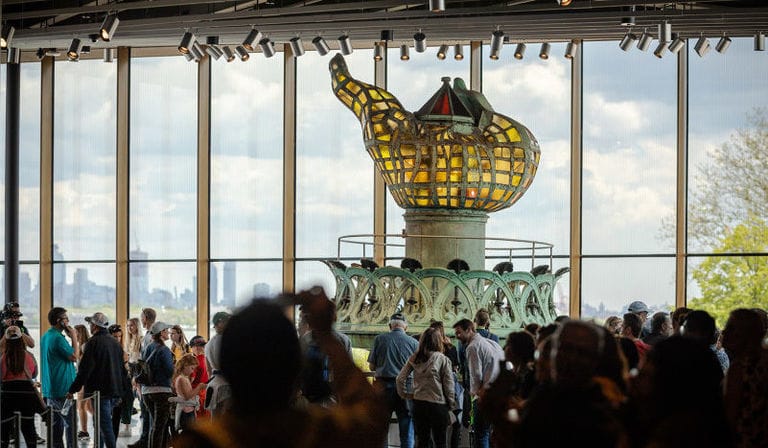
Statue of Liberty Museum
This museum is located on the opposite end of Liberty Island and is meant to better inform visitors of the significance of the statue. Alongside a theater, gallery spaces, and the original torch, it houses immigration artifacts from nearby Ellis Island.
People Keep Visiting
The number of visitors drawn to the Statue of Liberty has steadily grown over the past few years. Nowadays, nearly 4.5 million people catch a ferry to Liberty Island to visit the iconic statue.

Hurikat
Tourists and visitors love to check out the Statue of Liberty for a variety of reasons. One is the fact that it’s an affordable tourist activity. Another is to get a deeper understanding of the role Lady Liberty has played in American history. A third, of course, is to climb up to the crown. Have you had the pleasure to see this iconic and symbolic structure up close?
